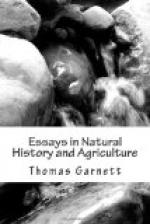Some of the male Kipper (Kelts) come down in December and January, but the greater part of the females remain in the river until April, and they are occasionally seen herding with shoals of Smolts in May. In this state they will take a worm very readily, and are, many of them, caught with the fly in the deeps; but they are unfit to eat, the flesh being white, loose, and insipid; although they have lost the red dingy appearance which they had when about to spawn, and are almost as bright as the fresh fish, their large heads and lank bodies render it sufficiently easy to distinguish them from fish which are only ascending the river, even if the latter were plentiful at this season; but this is unfortunately not the case.
Secondly, we have the Mort. I am not sure whether this fish is what is called the Grilse in Scotland, or whether it is the Sea Trout of that country; it is a handsome fish, weighing from one and a half to three pounds. We first see Morts in June; from that time to the end of September they are plentiful in favourable seasons in the Hodder, a tributary stream of the Ribble, although they are never very numerous in the Ribble above the mouth of that stream. It is the opinion of the fishermen here that this is a distinct species; my own opinion is, that it is a young Salmon, and yet, if I were called upon to give reasons for thinking so, I could not offer any very conclusive ones: the best I have is, that there is no perceptible difference in the fry when going down to sea. It may be said, How do you know that one of the three or four varieties of Smolts which you describe further on, is not the fry of the Mort? To this objection, if made, I say that these varieties exist in the Wharfe, where, owing either to natural or artificial causes, there is never either a Mort or a Sprod (Whitling?) seen.
Thirdly, we have the Sprod, which is, I believe, synonymous with the Whitling, Whiting, or Birling of Scotland. It is a beautiful fish of six or eight ounces in weight, and has more the appearance of the Salmon than the Mort; it seldom ascends the river before July, and, like the Mort, is far more abundant in the Hodder than in the Ribble; this fish sometimes rises pretty freely at the fly, and when it does so, makes a very handsome addition to the angler’s basket, but at other times it is difficult to hook, because of its shyness. It disappears in a great measure about September.
Fourthly, we have the Pink, or Par, which is found of two or three sizes in the Ribble; the largest are all males, and in October the milt in them is large; they are small fishes, ranging in weight from about one to three ounces each, and it is well remarked by the author of that delightful book “Wild Sports of the West,” they have very much the appearance of Hybrids between the Salmon and the Trout; they rise very freely at the fly and maggot, from July to October, and afford good sport to the angler who is satisfied with catching small fish. I trust I shall be able in the following pages to give some information respecting this fish which will assist in dispelling the mystery in which its natural history has been enveloped.




